Vertical Nomadism
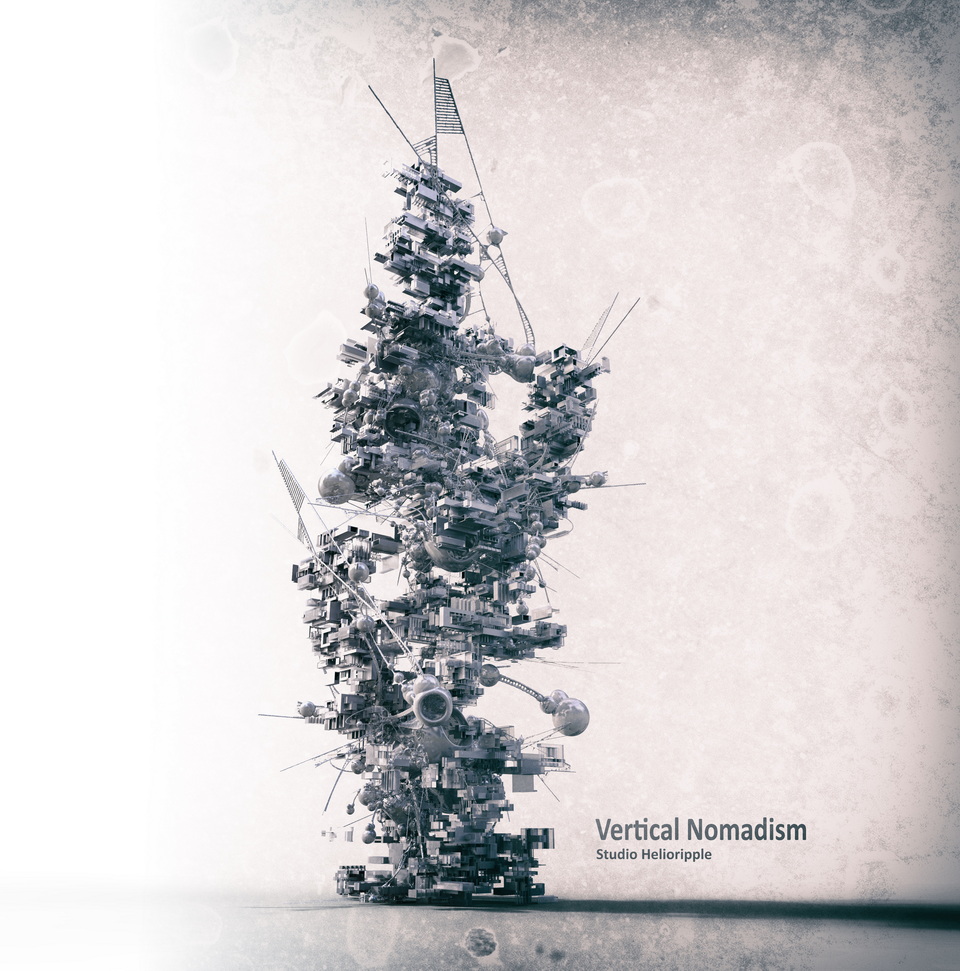
The unit was supposed to investigate different rules on particular cities, which could be generic or fictional cities. The system ran based on agent strategy, discovering the urban rules and applying them to their new vertical mode based on two main theories: Counter Gravity & Vertical Nomadism. Cities are occupied with the giant monstrous vertical elements that force humans to set over gravity. However, with the burst of the post-digital era, it will be inevitable to set some physical and mechanical laws alien to shared space, i.e., gravity as a primary challenge of verticality does not have power in the hyper-network world. As a result, the analysis of fictional/futuristic cities can lead to lucid translation of these laws into future metropolises.

Agent-Based Fictions
study of particles, agents, and their behavior in a defined environment. Design a simple game example using processing/grasshopper. To design for this unpredictable world, one must first know the rules and then let the components find their roles. Even social insects who had had different experiences with ours, before the first humankind species managed their cities overriding gravity rules and about to each other with more harmonic social rules than humans’.

The simple behavior is the specific form that allows particles that participants discovered in 2 weeks and used in their game engine frameworks: seek, wander, flee, pursuit, evade, obstacle avoidance, interpose, hide, path following, trace, etc. The result comprised:
-
Northwest Mansion Mystery
In 1920 there was an Evil inventor named “Ludwig Mies, van der rohe.” He invented the time travel machine, and he used it to travel to the future. After he traveled to 2020, he noticed that there were some guys in his house. His face became red from anger, And he started to make troubles for them, but they stood there like Irish to the house…
-
The BAT particle matters
The bat particle matter ” was the name that Batman assigned to one of his battles against Joker with the help of Flash. “It was another day like any others, Gotham citsupposed’y was calm, and everybody was off to their work until a piece of news breaking that joker is taking people as hostages. As I saw the news, I got ready to help. On my way, I see some people that hit the floor as they’re standing or crash themselves into walls for no Explosion. Seeking help, I heard a familiar voice. I turned around and saw Flash or, better say, drunk Flash…”
-
Battle of Berlin (100$ Mustache)
This movie was produced in a village named “Charita” in Argentina where three Characters of the game (Hitler, Woody Allen, Benjamin Franklin) met each other accidentally. According to their different beliefs, they tried to kill or protect each other. So, Charita will become like a battle between three different thoughts. A freeman and a Nazi make everything miserable when a Jewish comedian roams around! A war is going to break out.
-
Drake’s family (9Le double vie de Drac)
Drake’s family Lives in a castle in the city. They have to leave home at night to find food. So they transform into Dracula every night and scatter in the city. They face three things: crosses, humans, and hunters.
Layering Cities Based on ‘Parc de la Villette’
The unit was supposed to investigate different rules on remarkable cities, which could be generic or fictional cities. The system ran based on agent strategy, discovering the urban rules and applying them to their new vertical mode based on two main theories: Counter Gravity and Vertical Nomadism. With understanding the concept of indeterminacy & trying to control its boundaries, the purpose was to redefine social concepts like void, intermezzo & public spaces. Students had to generate a database of maps (12x12 pixel grayscale images) that represented each of these concepts and stack or project these maps through. Monolith voxel-based software to make 3D models. The practical step begins with the maps tagged with the properties of the references. Thenceforth, the students were only allowed to use this database as the ingredient as the layers to create their cities. The techniques they implemented were stacking images over each other in three axes based on their theory. As part of international competition, 1982, to revitalize the abandoned land from the slaughterhouse in Paris. Bernard Tschumi was chosen from many entries, including that of OMA/Rem Koolhaas. The Studio in this section focused on investigating these two attitudes toward design for a piece of land and extending the essence of those notions to program new imaginary cities with the power and social distribution they derive from the result of those two designs. Students were divided into two groups and began a new subjective challenge.
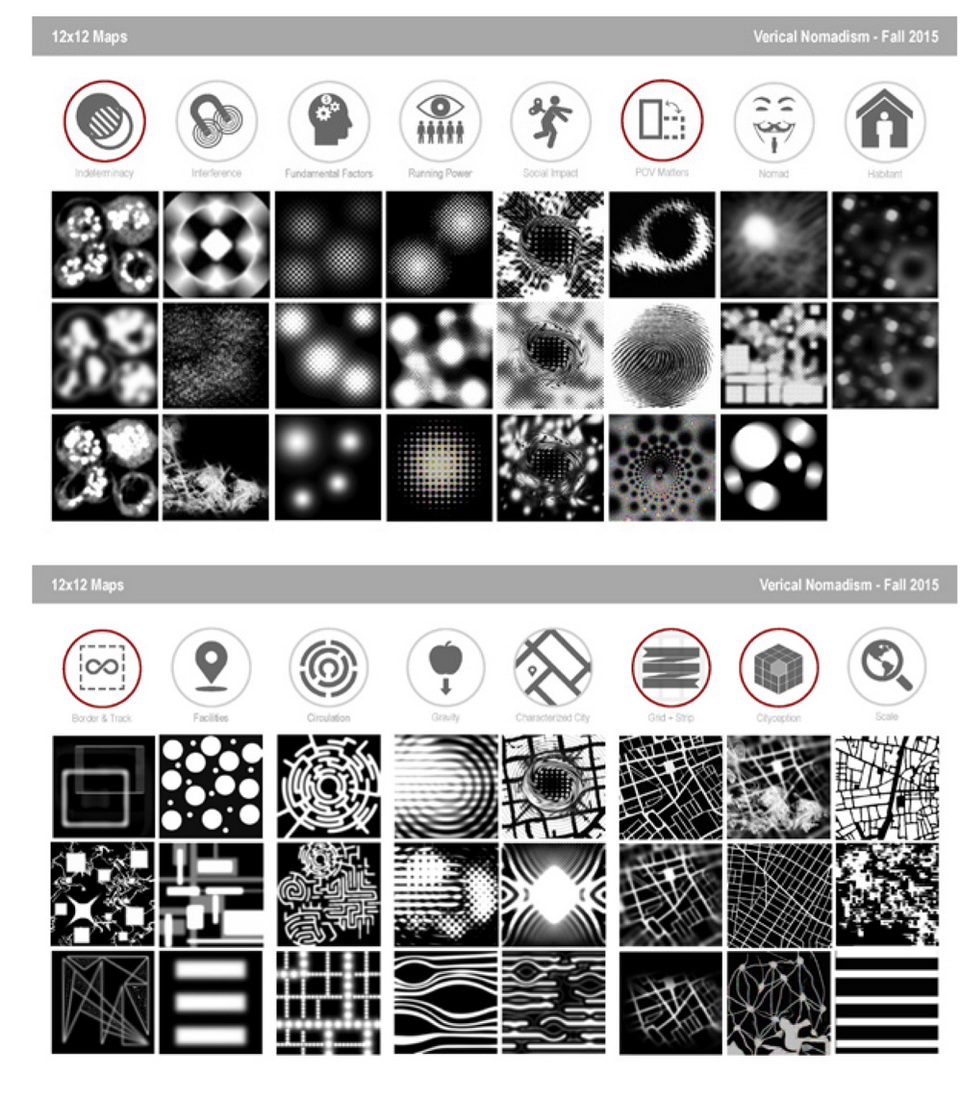
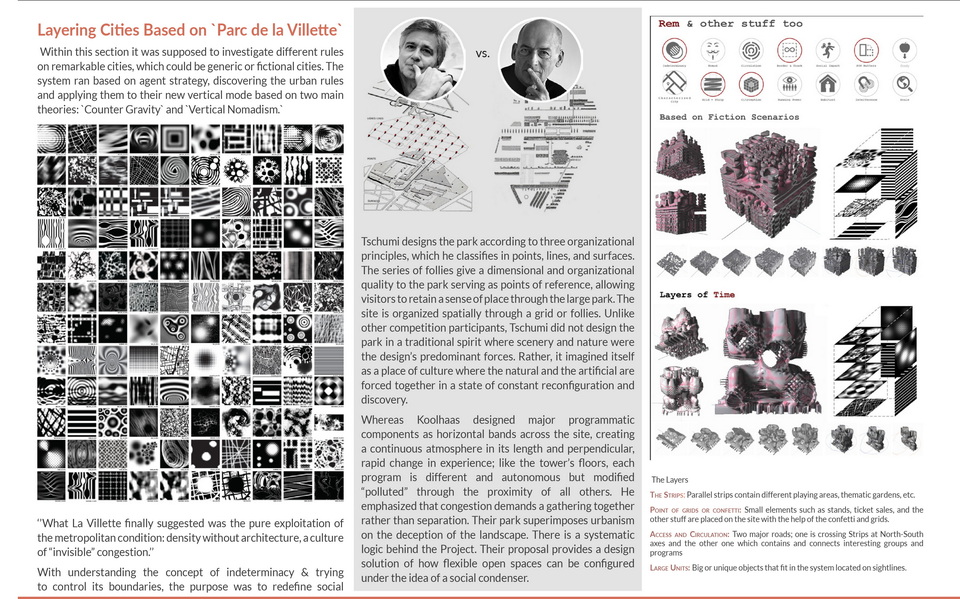
Tschumi designs the park according to three organizational principles, which he classifies in points, lines, and surfaces. The series of follies give a dimensional and organizational quality to the park serving as points of reference, allowing visitors to retain a sense of place through the large park. The site is organized spatially through a grid or follies. Unlike other competition participants, Tschumi did not design the park in a traditional spirit where scenery and nature were the design’s predominant forces. Rather, it imagined itself as a place of culture where the natural and the artificial are forced together in a state of constant reconfiguration and discovery. As part of Tschumi’s overall goal to induce exploration, movement, and interaction, he scattered ten themed gardens throughout the large expansive site that people would stumble upon either quite literally or ambiguously. The Tschumi lines are essentially the main traffic lanes delineated throughout the park. Unlike the follies, the paths do not follow any organizational structure; rather, they intersect and lead to various points of interest within the park and the surrounding urban area.


Whereas Koolhaas designed major programmatic components as horizontal bands across the site, creating a continuous atmosphere in its length and perpendicular, rapid change in experience; like the tower’s floors, each program is different and autonomous but modified “polluted” through the proximity of all others. He emphasized that congestion demands a gathering together rather than separation. Their park superimposes urbanism on the deception of the landscape. There is a systematic logic behind the Project. Their proposal provides a design solution of how flexible open spaces can be configured under the idea of a social condenser.

Layers
-
The Strips: Parallel strips contain different playing areas, thematic gardens, etc.
-
Point of grids or confetti: Small elements such as stands, ticket sales, and the other stuff are placed on the site with the help of the confetti and grids.
-
Access and Circulation: Two major roads; one is crossing Strips at North-South axes and the other one which contains and connects interesting groups and programs.
-
Large Units: Big or unique objects that fit in the system located on sightlines.
-
What La Villette finally suggested was the pure exploitation of the metropolitan condition: density without architecture, a culture of “invisible” congestion.’’
Density, land limitations, and the cost of human living infrastructure in growing metropolises lead humans to transition to the vertical direction as the main city development direction. In such a metamorphosis, architectural structures such as Wade, public spaces, squares, and neighborhoods need to be redefined. At the same time, we live in an occasional era where information is penetrating cities in different levels, from natural environments to virtual world dialogues, producing complex maps that can form the basis of strategy design. In this regard, Evolver Studio experimented with code and prototypes to explore data analysis for use in architectural design. It concluded that entering a competition has long been a challenge for architects. Therefore, it involves a data-driven design process to solve an urban architecture problem.
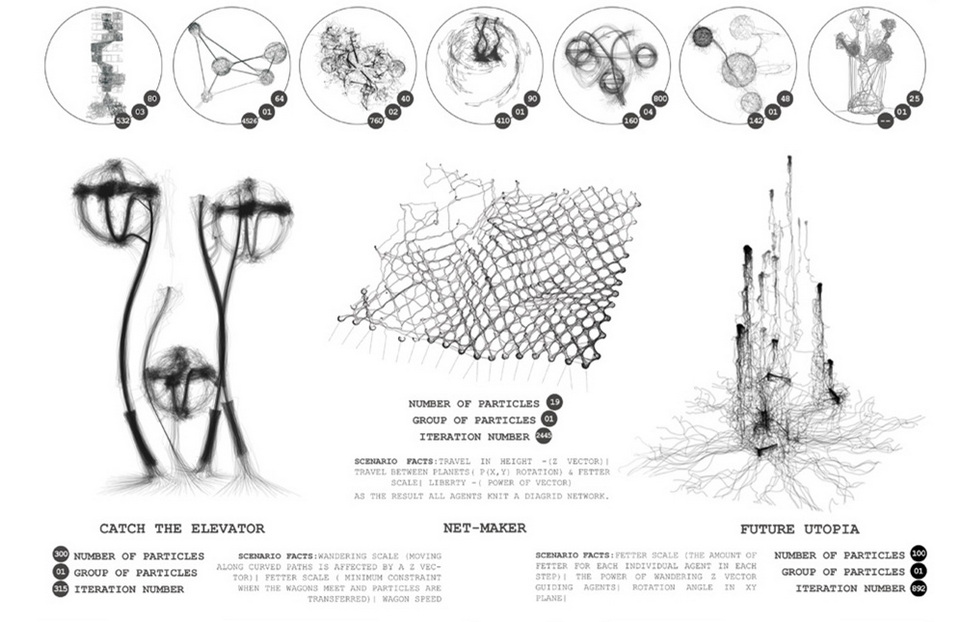
Wooly Travelers
Imagine the world with particles and agents in different kinds of society such as music, science, daily life, etc. behavior of these agents may cause a different variation of events depending on them or their environment. for example, the behavior of people catching a train. If a physical system is followed through a fold bifurcation, the system will suddenly transition to a new, very different behavior. This bifurcation value of the parameter a is sometimes called the “tipping point.” The key concept used in this process was the ‘Fold Catastrophe’ theory.
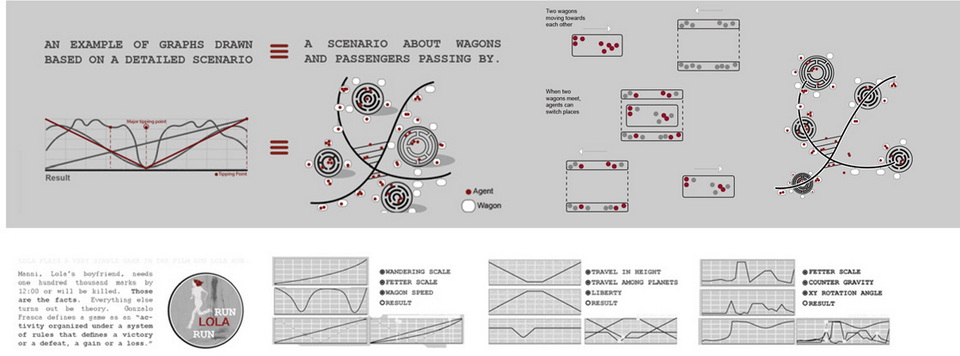
This enhances the following scenario-based design. All projects made several groups of points as an initial population with a specific movement, path (mesh) dependency, and wandering behavior (which can be controlled by a drawn graph in rhino) to catch their trains. Everything else turns out to be theory. For example, Gonzalo Frasca defines a game as an “activity organized under a system of rules that defines a victory or a defeat, a gain or a loss.” The reference point in design was the german movie name “Lola Renate” or “Run Lola Run” Lola plays a very simple game in the film based on such theory.
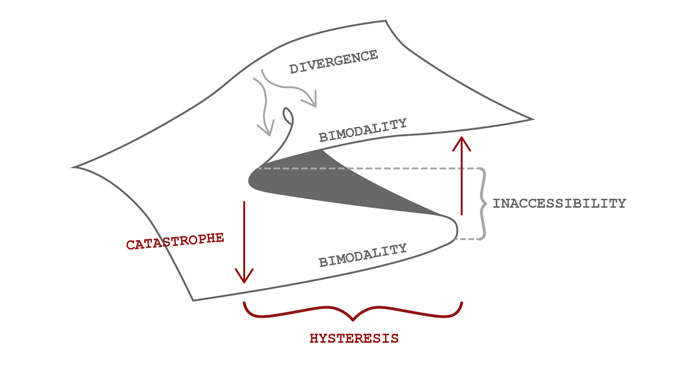
The topics consisted of: Self-organization is the process by which the internal organization of a system, usually an open system, evolves to greater complexity without being guided or exercised by external factors. It has been managed. Artificial machines and systems in previous centuries acquired their structures and organizations due to exterior plans and commands. In contrast, many natural systems are self-organizing according to their internal processes and laws, structured and systematic. As a practice, this design approach helps designers observe the CoreLogic factors for architecture or urban design as a live program that leads to a self-organized system. Methodologically, this studio stepped into such a field and experimented with an alternative design approach.
Final Projects
At the end of the studio, the students were divided into two groups to achieve the final goal. The final task was critical design due to the subjects of ‘Vertical nomadism’ and ‘Counter Gravity’ that expected them to have a computational approach to reach the target.
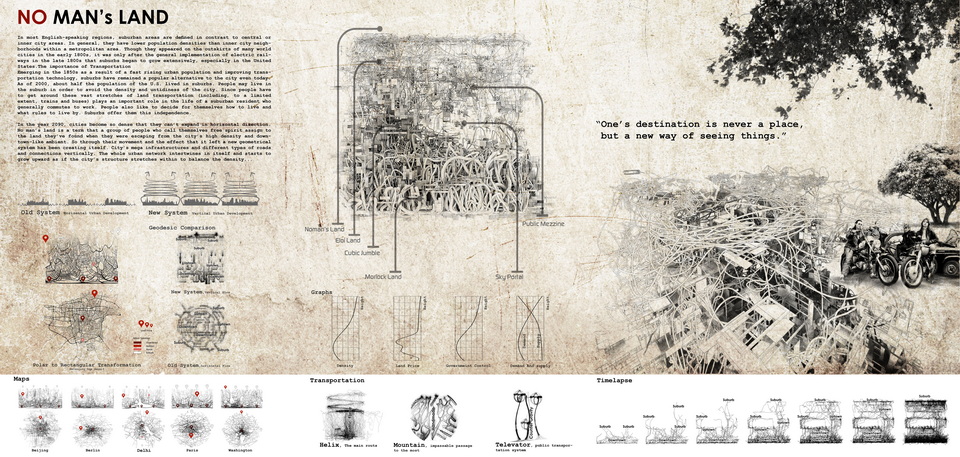
No Man’s Land
In the year 2090, cities become so dense that they can’t expand horizontally. No man’s land is a term referring to a group of people who call themselves free spirit assigned to the land they’ve found when they were escaping from the city’s high density and downtown-like ambient that it has become, a place that yet is untouched. These lands are not likely on the ground - as they’re filled with cities, but on the rooftops. They will terrorize the city’s flat roofs and make it their own as if they are living in the countryside. So, as the free part of society, they started to ride their motorcycles and enjoy these free lands while there’s nothing above to restrict them. Until the mighty ones, wealthy people who are also tired of the crowd and bustle of the city and want some peace and quiet in somewhere like the suburbs they’re used to going before, see the opportunity and use their money and power to make their way to the top. They start to expand the city’s mega infrastructures and different types of roads and connections vertically.
The whole urban network intertwines in itself and starts to grow upward as if the city’s structure stretches within to balance the density. Thus a new system has been creating itself through this process. It is a dynamic system that results in a fast-developing city that no one can define its zones as downtown, uptown, suburb, or slums without stopping the timer as their quality changes with time.
Unlike the prior urban systems and cities with horizontal development, this system is mostly evolves based on a counter gravity movement that forms most of its connected networks, using forces like eccentricity and transportation means like vertical funicular or centrifuge based helix structured roads to deviate and tilt gravity in order to obtain vertical flow. Public spaces in such a city may function differently; a plaza is a place that people gather to see the sky and nature, and it’s called a sky portal, or the suburb-to-be free land that has not been possessed yet is called No Man’s Land. The supply and demand rate of land is in constant change since there was no specific place or pattern for the growth and development of the city when it all started; the next step may be anywhere at any time. The rooftops of a zone formerly known as uptown could become downtown after a while, passing some developments. The city can only be explained in a specific period of time. But no matter what, the story continues because the free spirits will never stop riding their motorcycles to discover The No Man’s Land…
In most English-speaking regions, suburban areas are defined in contrast to central or inner-city areas. In general, they have lower population densities than inner-city neighborhoods within a metropolitan area. Though they appeared on the outskirts of many world cities in the early 1800s, suburbs began to grow extensively, especially in the United States, only after the general implementation of electric railways in the late 1800s. The importance of Transportation. Emerging in the 1850s as a result of a fast-rising urban population and improving transportation technology, suburbs have remained a popular alternative to the city even today.
As of 2000, about half the population of the U.S. lived in the suburbs. People may live in the suburb in order to avoid the density and untidiness of the city. Since people have to get around these vast stretches of land, transportation (including, to a limited extent, trains and buses) plays an important role in the life of a suburban resident who generally commutes to work. People also like to decide for themselves how to live and what rules to live by. Suburbs offer them this independence.
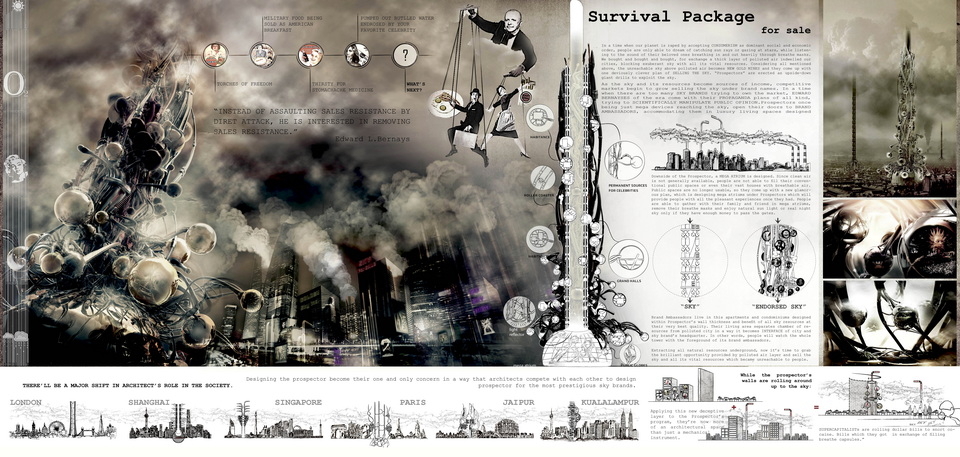
LEED
In a time when our planet is raped by accepting CONSUMERISM as dominant social and economic order, people are only able to dream of catching sun rays or gazing at stars while listening to the sound of their beloved ones breathing in and out heavily through breathe masks. We bought and bought and bought, for exchange a thick layer of polluted air indwelled our cities, blocking exuberant sky with all its vital resources. Considering all mentioned above, the unreachable sky above polluted air becomes NEW GOLD MINES, and they come up with one deviously clever plan of SELLING THE SKY. “Prospectors” are erected as giant upside-down drills to exploit the sky. As the sky and its resources become sources of income, competitive markets begin to grow, selling the sky under brand names. When there are too many SKY BRANDS trying to own the market, Edward Bernayses of the era come with their PROPAGANDA plans of all kinds, trying to scientifically manipulate public opinion. Prospectors, once being just mega devices reaching the sky, open their doors to BRAND AMBASSADORS, accommodating them in luxury living spaces designed.
The downside of the Prospector, a MEGA ATRIUM is designed. Since clean air is not generally available, people are not able to fill their conventional public spaces or even their vast houses with breathable air. Therefore, public spaces are no longer usable, so they come up with a new glamorous plan, which is designing mega atriums under Prospectors, which will provide people with all the pleasant experiences once they had. People can gather with their family and friends in mega atriums, remove their breathe masks, and enjoy natural sunlight or real night sky only if they have enough money to pass the gates. Brand Ambassadors live in these apartments and condominiums designed within Prospector’s wall thickness and benefit of all-sky resources at their very best quality. Their living area separates a chamber of resources from a polluted city in a way it becomes INTERFACE of the city and sky brand’s headquarter. In other words, people will watch the whole tower with the foreground of its brand ambassadors. Extracting all-natural resources underground, now it’s time to grab the brilliant opportunity provided by the polluted air layer and sell the sky and all its vital resources, which became unreachable to people.